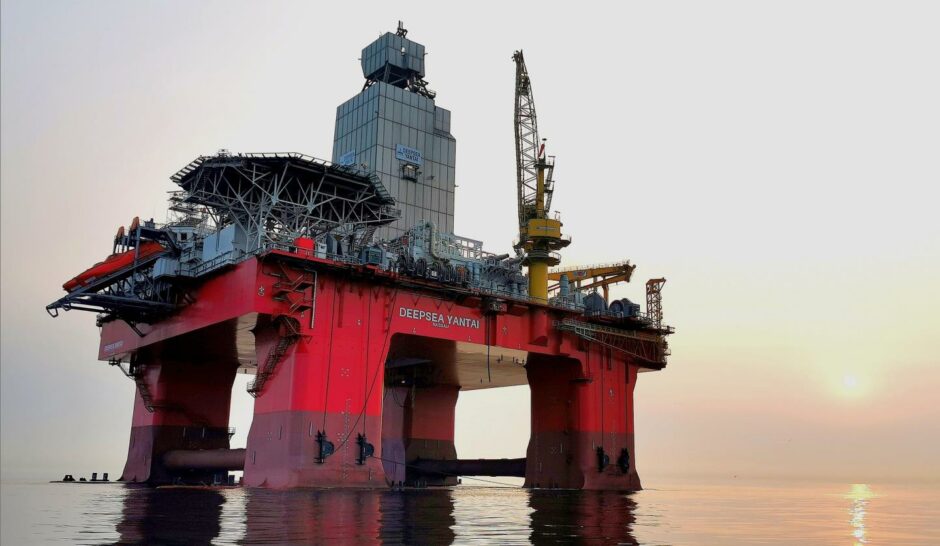
As of 28 February, Westwood Global Energy reports that there are four exploration wells active on the NCS. Two exploration well programmes completed in January, both as a dry holes. The Ginny and Hermine well has also been announced as dry and completed in February.
North Sea
Neptune spudded the 35/9-16 S Hamlet exploration well adjacent to Gjoa Field with the Deepsea Yantai semi sub. The well is targeting the Lower Cretaceous Agat Formation and is understood to be an extension of the 35/9-3 discovery that was drilled in 1997 and discovered gas in the Upper Cretaceous Kyrre Formation and oil and gas in the Lower Cretaceous Agat Formation. The well was scheduled for Q3/Q4 2020 but got deferred to 2021 following the Covid-19 pandemic and has been deferred again to 2022. The well has a 45-day dry hole duration and tie-back to Gjoa is expected if an economic discovery is made.
Equinor spudded the 34/4-17 S Statfjord Kile exploration well on 31 January 2022 with the Deepsea Stavanger semi sub. It was however junked after eight days, and the rig mobilised to Floro in Norway to load equipment before returning to the well location to re-spud on 11 February as the 34/4-18 S well. The is well is located to the north of the Snorre field and is targeting the Lower Jurassic – Triassic Statfjord Formation, assumed to be in a tilted fault block. The well has a 44-day dry hole duration and a successful discovery is expected to be a tied back development to the nearby Snorre field.
Aker BP spudded the 25/2-23 S Grefsenkollen / Øst Frigg exploration well on 24 December with the Deepsea Nordkapp semi sub. The well is targeting remaining resources in the oil and gas cap of the decommissioned Eocene Øst Frigg/East Frigg structure and the Middle Jurassic Tarbert Formation reservoir in the Grefsenkollen gas condensate prospect. The 25/2-23 A sidetrack was kicked off on 4 January. This was a planned sidetrack to collect data and cut core if the initial well proved sufficient volumes in the Øst Frigg structure, which Westwood assume is the case. The sidetrack is now suspended with a completion date of 22 January. The initial well 25/2-23 S is currently active again as of c. 22 January, targeting the Tarbert Formation. The well is located over the eastern part of the Øst Frigg decommissioned field and has a c. 92-day dry hole duration, plus an additional 12 days to sidetrack.
Wellesley completed the 36/1-4 Hemispheres exploration well on 30 January with the Borgland Dolphin semi sub, having spudded on 18 December. The well was targeting oil and gas in shallow marine sandstones of the Middle Jurassic Krossfjord Fm, in a faulted three-way dip closure. The well encountered 33m (108ft) of poor to moderate quality reservoir in the Krossfjord Formation which was water bearing but with traces of hydrocarbons. A further 33m (108ft) of poor to moderate quality reservoir was encountered deeper in the well, however the age was unknown and was also water bearing. The well was P&A as a dry hole.
Norwegian Sea
Equinor spudded the 6305/5-C-3 H Ormen Lange Deep exploration well on 18 February with the Transocean Barents semi sub. The well is targeting the Upper Cretaceous Lysing Formation and the Lower Cretaceous Lange Formation in a combination trap similar to the Ormen Lange field, which has reservoirs in the Paleocene and Upper Cretaceous Maastrichtian. The well has a 60-day dry hole duration and, if successful, is expected to be tied back to the Ormen Lange field under which it lies.
Equinor completed the 6407/9-13 Ginny/Hermine exploration well on 14 February with the West Hercules semi sub, having spudded on 31 December 2021. The well was targeting oil and gas in Upper – Middle Jurassic sandstones within a tilted fault block. JV partner OKEA and Longboat Energy announced that the well encountered the target reservoirs, but they were water bearing. The primary Upper Jurassic Melke Formation target found 27m (89ft) of very good quality reservoir, but no reservoir was encountered in the Rogn Formation. The secondary Hermine target was the Middle Jurassic Garn and Ile Formations, which encountered 76m (249ft) and 17m (56ft), respectively, of good to very good reservoir. The well was P&A as a dry hole.
Barents Sea
There is no current E&A drilling in the Barents Sea. The next exploration well in the region is expected to be on Equinor’s 7220/8-2 S Snøfonn Nord prospect in Q1 2022.
Recommended for you
